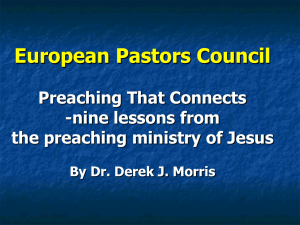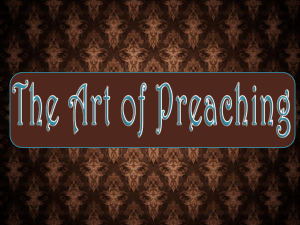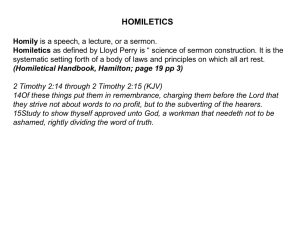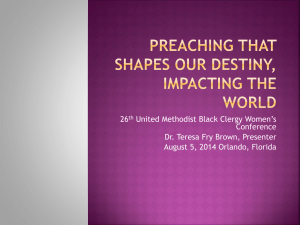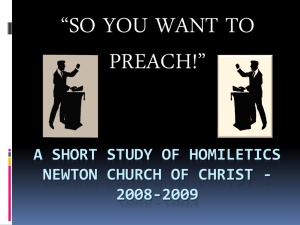- Scripture Unpacked
advertisement
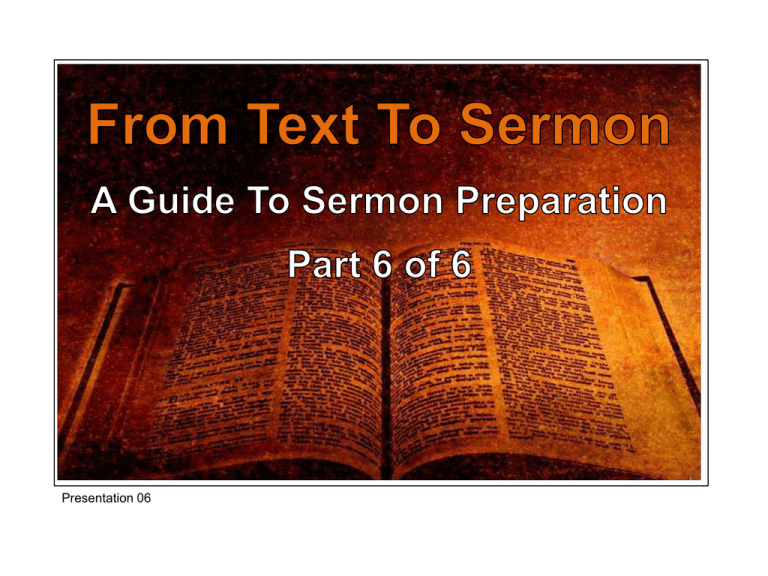
Presentation 06 Introduction If the process of preparation of the text of scripture thus far has neither, stimulated your mind nor, warmed your affections then that will be conveyed in the pulpit. No matter how gripping your introduction or importunate your conclusion you will have failed your people. Freshness is the result of constant study. The advice given me by a senior liberal minister on the night of my ordination was, “Spend the first year working on a range of sermons and you will have enough material to last the remainder of your ministry. You will only need to revamp your sermons a little”! To have followed such advice would, among other things, have robbed preaching of its freshness. Presentation 06 Contents: Study 1: Introduction: Approach To Scripture Approach To Culture Approach To The Hearer Study 2: Selecting The Passage Understanding The Passage Study 3: Determining The Thrust Of The Passage Formulating The Preaching Idea Study 4: Determining The Sermon’s Purpose How To Accomplish That Purpose Study 5: Outlining And Fleshing Out The Sermon Study 6: Application, Conclusion And Introduction Presentation 01 Application The Westminster Confession speaks of the ‘conscionable hearing’ of the Word of God. In other words the hearer is to hear the word of God as an act on conscience binding him to obey God. So that in response to the sermon he is able to say ‘this is what I must do’. Significantly, Peter’s sermon at Pentecost met with conscionable hearing as the Spirit of God along with the ally of conscience called out a response, “What must we do to be saved”. They were saying we have got the point what is your concluding application? We need direction! We are ready to obey! To which Peter replied “repent and be baptised”. Presentation 06 Application It is important to remind ourselves when addressing fallen men and women that, in a very particular way, we can rely on both conscience and the Holy Spirit to assist in the business of application. The Holy Spirit’s role has been published by Jesus, “he will convince the world of sin, righteousness and judgement to come”. Jn 16. While the human conscience can be manipulated and supressed nevertheless it has a distinctive function which is engaged as we preach, ‘Conscience is God's spy and man's overseer. Conscience the domestic chaplain’. JOHN TRAPP Presentation 06 Application That said, application is the area where the preacher must work hardest but it also tends to be the area that suffers the greatest neglect. I suspect that along with prayerlessness and pride a failure to adequately apply the truths expounded comes up fairly high on the list in the minister’s confessional. Application is often left to a few sentences at the conclusion of the sermon but can and should be made at appropriate points throughout. The reason for doing so is not simply to catch out seasoned sermon tasters, who judge that the appropriate time to switch off is in the last 10 minutes lest they be made to feel uncomfortable! Presentation 06 Application The reason for making application of truth throughout the sermon is that it forms a necessary part of the process of unpacking scripture. It should be done in a way that neither interrupts the sermon flow nor distracts from the sermon’s purpose. And it is good to ask if we have done before shaping our conclusion. John Owen mastered this approach to such an extent that it was said of him, “all his doctrine was application and all his application was doctrine.” Presentation 06 Application There are many who think that as long as they expound doctrine faithfully then it is the task of the Holy Spirit to apply it. While we do not seek to diminish the significant part played by the Holy Spirit, it is an abdication of the preacher’s responsibility to stop short of application. Thomas Brooks the Puritan preacher argues as follows: “A general doctrine not applied is as a sword without an edge, not in itself, but to the people, who by reason of their own singular sensitiveness and weakness are not able to apply it to their own estates and conditions; or as a whole loaf is set before children that will do them no good”. Presentation 06 Conclusion Introductions and conclusions have significance in a sermon that is out of proportion to their length. During the introduction the hearer will often decide how much attention he is prepared to give to your sermon. While the conclusion seeks to elicit a response which is based upon the text that has been expounded and answers the question in the hearer’s mind and heart, “What must I now do?” Presentation 06 Conclusion Like a pilot, the preacher must not be uncertain about where his sermon will land. Don’t leave your conclusion to the inspiration of the preaching moment! The conclusion is generally drafted before the introduction, because you know exactly where the sermon is intended to lead your hearers. It is used to drive home your proposition by calling for the response it told us the text requires. The purpose of the conclusion is to conclude not merely to stop. There is a difference! Many young preachers fly in a holding pattern stacked for landing but fail to land! Presentation 06 Conclusion In the conclusion more is required than the vague generalisation, ‘May God help us all to live in the light of these great truths’. The application of Christ to man’s need should never be a bland, ‘And of course we couldn’t do this without the grace of God in Christ’. So often Christ is left out of the sermon only to be pulled like a rabbit out of a magician’s hat at the very last minute. In the process of drawing to a close it has been said that “a preacher should never say ‘finally’, and certainly not more than once”. Presentation 06 Conclusion In your conclusion you are urging upon your listeners a practical response and pleading with them to take seriously what God has said through his word. You are drawing the threads of your outline together indicating how they undergird the proposition you have presented. Ensure that your recapitulation does not sound like a mindless summary of what you have just told them. Presentation 06 Conclusion The ‘mindless summary,’ danger can be avoided by recasting your language, by coming at the truth from a slightly different angle that says the same thing but in a different way. This can be done by presenting a believable, contemporary example of response to the text. In this way the hearer is able to see how the Holy Spirit might work this text into their lives too. Be sure to be brief and don’t add new teaching material at this point. You should be focussing your hearers thoughts and not diffusing them. Presentation 06 Conclusion During the troubles in Northern Ireland I had been preaching though the Lord’s Prayer and the text for the following Sunday was “forgive us our debts…”. Days before there had been an explosion at the Remembrance Day service and Gordon Wilson’s young daughter had been killed. Interviewed by the media, the reporter clearly expected him to pour out invective and hatred on those responsible. However, his words impacted all who heard. He said, “I bear them no ill-will, I am a Christian and I have tasted God’s forgiveness. I readily forgive these men, they are regularly in my prayers.” What better way to close a sermon on forgiveness as people are thinking, ‘its not easy to forgive those who have done us harm’. Presentation 06 Conclusion We aim for response BUT we do not seek to manipulate response. We are not called upon be ‘string pullers’. We do not rely upon our crafted sermon or thoughtful delivery but on the faithfulness of God to accomplish his purpose in the hearts of our hearers. Now that conviction needs to be reflected in the way in which we conclude our sermon. We will make it clear that we expect response to the word as our hearers engage with God in the light of what has been presented. In this context, prayer is often appropriate at the conclusion of a sermon. Presentation 06 Introduction The introduction should be drafted last of all even though it comes first in our delivery. That is because until you know where your sermon is going you do not know how best to start the journey. You are not taking your hearer’s on a mystery tour! During the introduction the hearer will often decide how much attention he is prepared to give to your sermon is it really relevant to them for they live in the ‘hear and now’! An introduction should command attention and give our hearers a reason for listening while at the same time it helps establish our credibility as messengers. We want to present ourselves as people who are to be taken seriously and jokes and humorous stories which have no bearing on our subject fail to do this. Presentation 06 Mystery Tour Introduction The opening words of a sermon need not be dramatic but they must go after the minds and hearts of the hearers to force them to listen. Most of us need to be reminded that God has a word for us today, that he continues through scripture to speak into our situation today. Do not feel obliged to use the introduction to demonstrate every conceivable truth that might be dug up from the text before announcing which one you plan to unpack. This simply confuses them and might even cause them to develop one of these lines of thought while you are preaching! One student had six introductory comments concerning the truths that he could have excavated from the text. He wanted to let his hearers know that he knew they were there even although he would not deal with them. Presentation 06 Introduction A number of devices can be used to get you started - human interest stories, provocative statements , news reports, cultural commentary. In addition a sermon can start with a paradox, ‘Many children of God live as though they are orphans’. Rhetorical questions can be used, ‘If God were to die this morning how long would it take you to find out?’ A startling statistic can gain the hearer’s attention, ‘One out of three marriages end in divorce.’ A quotation might be employed, ‘Religion is the opium of the masses” Presentation 06 Introduction The social scientist, Arthur Cohen, has argued that when audiences receive information that meets felt needs, more learning takes place and opinions change faster and more permanently. A good introduction will make people listen not because they ought to but because they want to. Early in the sermon the congregation should realise we are talking to them about them! Our goal is to raise the issue that the text addresses so that we are pointing to a problem, a deficiency, need, challenge or an opportunity to which the Bible gives the solution and provision. Presentation 06 Reviewing The Language Used The preacher in Ecclesiastes tells us of his search to find just the right words [12v9-10]. Though reading from a full manuscript can deaden communication, the discipline of writing out one’s sermon in full concentrates the mind on the choice of vocabulary that will best communicate your subject matter. Avoid clichés, slogans, and ‘general’ truths. Bear in mind that clarity decreases as sentence length grows. Beware too of using jargon and specialised vocabulary that the hearer will not understand. Your goal is not to impress others with the richness of your vocabulary or the breadth of your grasp of the great doctrines of grace but to clearly drive home the Word that God has given you. Presentation 06 Reviewing The Language Used Legend has it that a few years ago a young copywriter came up with an advert for a new kind of soap. It read as follows; "The alkaline element and fats in this product are blended in such a way as to secure the highest quality of saponification, along with a specific gravity that keeps it on top of the water, relieving the bather of the trouble and annoyance of fishing around for it at the bottom of the tub during his ablution." A more experienced ad man captured the same idea in two simple words, ‘It floats’. Presentation 06 Holding Interest Many preachers have heard the criticism. “The sermon was too long”. Now that can often be because the hearer has no appetite for spiritual truth. But it may also be because the preacher has failed to gain or hold his hearer’s interest. John Stott’s advice to those who are told their sermon’s are too long is to make them more interesting. It is better to leave your hearers wishing they could hear more than wish you had stopped 20 minutes ago. An influential Scottish preacher, William Still, would regularly preach for 1 ½ hours but it seemed like just a few minutes. Presentation 06 A Cautionary Note “My lifetime has been a preparation for preaching. But more particularly I prepare my sermons for others by preparing my own heart. In this prayer and Bible study are chief factory. When I read books other than the Bible they are read not that parts of them might be included in my address but to enrich my own thought and to quicken and inspire my faith. Thus I spend a deal more time in preparing myself for preaching. Many make the mistake of giving more time to the preparation of their address, than to the preparation of their own hearts affections, emotions and faith; the result often is beautiful, brilliant words that have the same effect of holding up glittering icicles before a freezing man. To warm others, and is this not the purpose in preaching, a man must keep the fire burning hot in his own heart”. SAMUEL BRENGLE Presentation 01 Conclusion The purpose of these presentations has been to try to help the preacher to approach the subject and process of sermon preparation with some thought. It is an abdication of responsibility to say, “The Holy Spirit will put the words into my mouth, I don’t need to prepare”. While you certainly do not need to follow all the suggestions that have been made, try to use or modify them as you see fit. Whatever your response ensure that your communication is biblical, clear, and captivating. Ask, “Am I honouring Christ as I preach. Do I aim to build up God’s people in their faith? Do I seek to present Christ and his gospel compellingly and winsomely to unbelievers?” To this end we are all learners in the glorious task of gospel communication. Presentation 06



